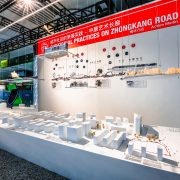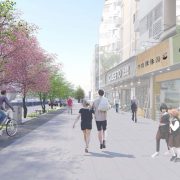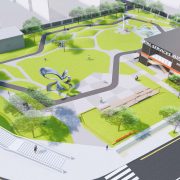
Curatorial Practices in An Urban Community - A Case of Zhongkang Road
Curatorial Practices in An Urban Community – A Case of Zhongkang Road / 城市社区的策展实践 – 中康艺术长廊
Shenzhen Center for Design 深圳市城市设计促进中心
Zhongkang Arts Corridor (ZAC) is a regeneration project focusing on the public realm along Zhongkang Road in the area of Meilin, Shenzhen. Shenzhen Centre for Design (SCD), being the main organiser of UABB, situated on the threshold of Zhongkang Road, and had been actively involved throughout the design and construction of the project. The main objectives are to catalyze Zhongkang Road’s public realm by inserting art while preserving its convivial street life, as well as enhancing its stormwater management and ecological system. This proposal is an integral one which considers landscape elements, transport, ecological engineering, retail frontages and public space (re)configurations.
Although sitting right on the extension of Shenzhen’s central axis, Zhongkang Road faces the situation of slightly “segregated” from the city center, partly due to its isolation caused by the North Ring Road. The public realm suffers from poor pedestrian environment, dilapidated urban facilities and lack of public spaces. In this area, Upper Meilin Village is an urban village with a history of over 840 years, and still remains densely populated with both residents and retailers in very high social mobility. Zhongkang Road is of good accessibility to surrounding natural resources, which creates a potential ecological walkway. Besides, it has a diverse and inclusive culture, embracing over 400 design studios in the area while having both a Christian church and a mosque. In a word, Zhongkang Road stands on an important location while enjoying abundant urban resources, its built environment and public realm is in need of regeneration to better serve its residents and visitors.
The SCD proposed to introduce Urban Curation as one of the main strategies of intervention. Curation, in today’s definition, has shifted from dealing with artefacts and art in a museum to a broader sense of generating and promoting creative activities. Interpret the city as a curated collection enables new possibilities for creating an inviting public realm and minimize the gap between public and art, which in turn, increases the sense of identity, pride and belonging of the local community.
Adapting the notion of “Urban Curation”, the design concept of ZAC can be viewed in three layers, namely the Container, the Exhibition and the Activator. At the basic level, the public realm will be retrofitted as a fully functioning road and “the Container” for the city lives and urban art. The sidewalks, pedestrian crossings, cycle lanes and public spaces are all improved. A vacant plot which informally occupied as car park is transformed into a community park of 4600 square meters. The sidewalks are enhanced through new permeable paving with the addition of a new cycle lane. Improvements such as raised pedestrian crosswalks are incorporated to prioritize the pedestrian experiences. Tree pits are enlarged to accommodate rain garden as part of the stormwater management system. The enhanced sidewalk will be the main thread which links thresholds, nodes and public spaces in the second layer — “the Exhibition” shown on the ZAC as an outdoor urban gallery.
In the process of Urban Curation, the SCD, acting as the main curator, associating over 17 organizations, designers and artists to contribute to “the Exhibition”. Through careful research and negotiations, the SCD sets six main nodes for public art along the road, includes decaying fence walls, underutilized public space and dilapidated facilities. Local elements are extracted by the artists to celebrate collective memories. The artists are also invited to utilize urban facilities such as manhole covers and substations as their intervene subjects.
Finally, “the Activator” highlights a stage where most of the construction work was completed, and collective activities will start to be inserted into ZAC as catalysts. This implies the ongoing process of an urban project that is always extending its conceptual boundary. Activities include but not limited to communities planting in the park, The Fifth Shenzhen Public Sculpture Exhibition, as well as a series of community-led exhibitions happen in the proposed “Wall Art Museum” — a series of linear exhibition spaces transformed from a dilapidated fence wall. The Container, the Exhibition and the Activator will exemplify a continuing and collective process of urban transformation on ZAC.
Today, Shenzhen constantly experiences ongoing writing and rewriting of the city in its every corner. Like every other area in Shenzhen, Meilin experienced a sweeping transformation during the past four decades, which externalized as a split in its past and present. The ZAC project and the SCD entails a role of connecting, as it links the area’s past and presents through artwork while associating different stakeholders and participants within and beyond the area. In the ZAC, people are invited to interact, to make, to record and to play with art in the public realm.
“中康艺术长廊”是一个城市公共领域的更新项目,位于深圳市梅林片区,同时也是福田中心区中轴线的北延段。深圳公共艺术中心作为深双的承办单位,位于中康路的起点,全程参与了本项目的策划和概念设计。该项目旨在提升环境安全、保护街区活力、增强道路生态系统及海绵城市建设的同时,借助艺术介入激活公共空间,并通过综合考虑景观、交通、公共空间、商业的融合,使城市慢行公共空间充满文化多样性。
尽管坐落在深圳中轴线北延段,但由于北环大道的分隔以及规划发展过程中的重视不够,中康路存在步行环境差、开发密集、公共空间缺乏等问题。中康路拥有丰富的城市、自然资源及浓厚的人文气息,发展潜力大,而沿路公共空间正待提升改造,来更好地服务其居民和访客。
“城市策展”是本次改造的主要策略。如今,“策展”一词的概念已日渐扩展,不再仅仅意味着在博物馆里研究和筹划文物、艺术品展览,而是指向更广泛的创意活动。如果把城市作为展览发生的场地来看待,策展需要邀请公众于公共领域参与体验艺术,拉近大众与艺术的距离的同时,也提升社区的认同感和归属感。
“中康艺术长廊”的设计概念分为三层,分别是“景观新容器”、“城市美术馆”和“社区活化器”。首先,中康路将系统地进行景观提升,改善交通及步行环境,置入一个面积4600平方米、由荒废多年的空地改造成的社区公园,并置入公共艺术作品。透水铺装及下凹绿地将促进海绵城市的建设,改善后的中康路将作为城市艺术品的“容器”。
在这个“城市策展”的过程中,深圳市公共艺术中心作为主策展人,将联合17个组织、机构、设计师及艺术家共同为“城市美术馆”出力。经过调研和沟通,我们选定了6个艺术介入的主要节点,包含老化围墙、闲置公共空间和破旧设施等。部分艺术家选择将本地元素抽象化,从而唤醒集体记忆。井盖、变电箱这类影响城市形象却常被忽略的城市设施,也将被艺术家们视为改善和美化的对象。
最后,一系列以社区为主导的活动将激活改造的几个场所,如梅丰社区小公园的社区共建花园、本地设计力量主导的“墙美术馆”等。“景观新容器”、“城市美术馆”和“社区活化器”将展示“中康艺术长廊”持续的、共同参与的城市蜕变过程。
Credits:
Team members: Lei Liu, Ya Liu, Yichen Xu, Guang Yang, Xiaofei Zhang, Ying YE, Zichao Huang 刘磊,刘雅,杨光,张晓飞,徐燚琛,叶颖,黄子超
Collaborators: Meilin Sub-district Office (梅林街道办事处) Shenzhen Institute of Building Research (深圳建筑科学研究院) Concept Design Collaborators:南沙原创,自组空间,今天艺术,卢远良,郭梦,刘国栋,叙事空间,青微舍,孔森







